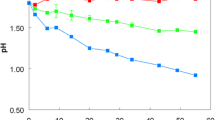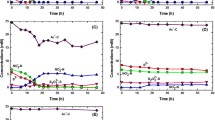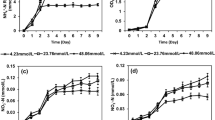Abstract
1. Dry weight yields from mixed cultures ofProsthecochloris aestuarii orChlorobium limicola with the sulfur reducingDesulfuromonas acetoxidans were determined on different growth limiting amounts of acetate, ethanol or propanol. The obtained yields agreed well with values predicted from stoichiometric calculations. 2. From mixed cultures of twoChlorobium limicola strains withDesulfovibrio desulfuricans orD. gigas on ethanol as the growth limiting substrate, dry weight yields were obtained as calculated for the complete utilization of the ethanol by the mixed cultures. 3. Dry weight yield determinations for two pure cultures ofChlorobium limicola with different growth limiting amounts of sulfide in the absence and presence of excess acetate confirmed that acetate is incorporated byChlorobium in a fixed proportion to sulfide; compared to the yield in the absence of acetate the yield is increased two to threefold in the presence of acetate. 4. The lowest possible sulfide concentrations necessary for optimal growth of mixed cultures of eitherProsthecochloris orChlorobium withDesulfuromonas on acetate were 7–8 mg H2S per liter of medium. 5. Doubling times at the growth rate limiting light intensities of 5, 10, 20, 50, 100 and 200 lux were determined under optimal growth conditions for the following phototrophic bacteria:Prosthecochloris aestuarii, Chlorobium phaeovibriodes, Chromatium vinosum andRhodopseudomonas capsulata. Reasonably good growth was still obtained withProsthecochloris at 10 and 5 lux light intensity at which no growth of the purple bacteria could be observed.
Similar content being viewed by others
References
Butlin, K. R., Postgate, J. R.: The microbial formation of sulfur in Cyrenaican lakes. In: Biology of deserts (J. L. Cloudsley-Thompson, ed.), pp. 112–122. London: Institute of Biology 1954
Caldwell, D. E., Tiedje, J. M.: The structure of anaerobic bacterial communities in the hypolimnia of several Michigan lakes. Can. J. Microbiol.21, 377–385 (1975)
Cohen, Y.: Dynamics of procaryotic photosynthetic communities of the Solar Lake. Thesis, Hebrew University Jerusalem 1975
Cohen-Bazire, G., Pfennig, N., Kunisawa, R.: The fine structure of green bacteria. J. Cell. Biol.22, 207–225 (1964)
Cruden, D., Stanier, R. Y.: The characterization ofChlorobium vesicles and membranes isolated from green bacteria. Arch. Mikrobiol.72, 115–134 (1970)
Gloe, A., Pfennig, N., Brockmann, H., Jr., Trowitzsch, W.: A new bacteriochlorophyll from brown-colored Chlorobiaceae. Arch. Microbiol.102, 103–109 (1975)
Van Dijken, J. P., Harder, W.: Growth yields of microorganisms on methanol and methane: a theoretical study. Biotechnol. Bioeng.17, 15–30 (1975)
Fenchel, T.: The ecology of marine microbenthos. IV. Structure and function of the benthic ecosystem. Ophelia6, 1–182 (1969)
Van Gemerden, H.: On the bacterial sulfur cycle of inland waters. Thesis, Univ. of Leiden (1967)
Gorlenko, V. M., Kusnezow, S. I.: Über die photosynthetisierenden Bakterien des Kononjer Sees. Arch. Hydrobiol.70, 1–13 (1972)
Jørgensen, B. B., Fenchel, T.: The sulfur cycle of a marine sediment model system. Mar. Biol.24, 189–201 (1974)
Matheron, R., Baulaigue, R.: Bactéries fermentatives, sulfate-reductrices et phototrophes sulfureuses en cultures mixtes. Arch. Microbiol.109, 319–320 (1976)
Oláh, J., Biebl, H., Overbeck, J.: Photoorganotrophic acetate utilization in a stratified eutrophic lake. Hidrol. Kőzl.1973, 21–27 (1973)
Olson, J. M., Prince, R. C., Brüne, D. C.: Abstracts Int. conference on the primary electron transport and energy transduction in photosynthetic bacteria. Free University of Brussels. Brussels, Belgium, Sept. 6–9 (1976)
Pfennig, N.: Photosynthetic bacteria. Ann. Rev. Microbiol.21, 285–324 (1967)
Pfennig, N.:Rhodopseudomonas acidophila, sp. n., a new species of the budding purple nonsulfur bacteria. J. Bacteriol.99, 597–602 (1969)
Pfennig, N., Biebl, H.:Desulfuromonas acetoxidans, gen. nov. and sp. nov., a new anaerobic, sulfur-reducing, acetate-oxidizing bacterium. Arch. Microbiol.110, 3–12 (1976)
Pfennig, N., Lippert, K.-D.: Über das Vitamin B12-Bedürfnis phototropher Schwefelbakterien. Arch. Mikrobiol.55, 245–256 (1966)
Sadler, W. R., Stanier, R. Y.: The function of acetate in photosynthesis by green bacteria. Proc. Natl Acad. Sci. U.S.46, 1328–1334 (1960)
Trüper, H. G., Schlegel, H. G.: Sulphur metabolism in Thiorhodaceae. I. Quantitative measurements in growing cells ofChromatium okenii. Antonie van Leeuwenhoek. J. Microbiol. Serol.30, 225–238 (1964)
Author information
Authors and Affiliations
Rights and permissions
About this article
Cite this article
Biebl, H., Pfennig, N. Growth yields of green sulfur bacteria in mixed cultures with sulfur and sulfate reducing bacteria. Arch. Microbiol. 117, 9–16 (1978). https://doi.org/10.1007/BF00689344
Received:
Issue Date:
DOI: https://doi.org/10.1007/BF00689344




